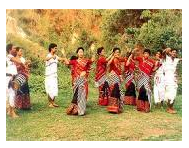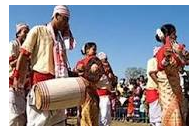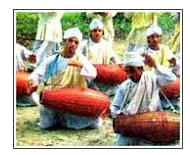Festivals and Fairs of Assam
Contents
- Introduction
- Various Festivals and Fairs
Introduction
Assam is the land of composite culture and tradition. Assam, home to several tribes celebrates different festivals all through the year. As agriculture is the primary source of livelihood of the tribes, most of the festivals are centred on agriculture. Some of the important festivals celebrated in Assam are
Bihu: Bihu is the New Year of Assamese. Bohag Bihu is celebrated on 14th April every year the first day of the first month- Bohag in the Assamese calendar year. The word Bihu is derived from the language of the Dimasa people. The word Bihu is a combination of “Bi” meaning to “ask” and “Shu” meaning pray for “peace and prosperity”. Bishu has gradually evolved as “Bihu”. Bihu is celebrated in three forms- Bohag Bihu or Rongali Bihu in April, Kati Bihu or Kongali Bihu in October- November and Maagh Bihu or Bhogali Bihu (also known as the harvesting festival) in January, end of the harvesting season.
Bihu is associated with farming. Bohag Bihu represents the celebrations at the beginning of the harvesting season. Rongali Bihu is the most colourful festival which is celebrated to mark the beginning of the agricultural season when seeds are sown. The first day of Rongali Bihu is known as “Goru Bihu”. On this day, cattle are worshipped. The cattle are smeared with turmeric paste and various other pastes, decorated with sprigs of ‘Dighalati’ and ‘Makhilati’ which contain different vegetables. The cattle are then herded to the nearby pond or river and given a ceremonial bath. The second day of the festival celebrated on April 15th is known as “Manuh” Bihu”. On this day people, old and young alike dress up in new traditional attire and usher in the New Year with great enthusiasm. Special delicacies are prepared and offered to the deity- Brai Shibrai the supreme deity, also considered as the deity of fertility is worshipped during the festival. The first crop of the season is offered to the deity- Brai Shibrai.
As part of the festival, hand woven scarf, known as “Gamocha” is gifted to the near and dear ones. The celebrations for the year will last for a month. People sing folklore and dance with the various musical instruments played in the background. The songs sung during the Bihu festival are known as Bihu Geet. Young men and women form separate groups and visit every household in their neighbourhood and pray for the welfare of the society at large through a joyous rendering of song, music and dance. Bohag Bihu is celebrated for seven days, with each day called by a different name such as: Chot Bihu, Goru Bihu, Manuh Bihu, Kutum Bihu, Senehi Bihu, Mela Bihu and Chera Bihu. Dumahi is the starting day of the festival. The day prior to Dumahi is called as Uruka. The start and the end day of the festival vary from community and tribe. Most of the tribes celebrate the spring festival starting from the first Wednesday of the month of Bohag (April), as Wednesday is considered to be auspicious. Some of the tribal community also start the land cultivation. Tribal youth sing songs to stimulate Mother Nature.
On the third day, Gosai Bihu, the images of Gods are cleaned and worshipped praying for a prosperous year ahead.
Kati Bihu or Kongali Bihu: Kongali means “poor”. The festival is named Kati or Kongali, as there is nothing much left to eat with the granaries of the village getting empty around this time. Kati Bihu is observed in October when the paddy is in the growing stage. This is a thanksgiving occasion to the Lord hoping for a good yield. An important ritual associated with Kati Bihu is lighting of the lamp in the evenings. Lamps are lit in houses and in the paddy fields. Lamps or candles or Saaki (earthen lamps) are lit in front of the Tulsi plant at the entrance of the house. Another belief associated with lighting the lamp in front of the house is to lead the soul of the dead in the family to heaven. In the paddy field, lamps, “Akaxh Banti” are lit on the tip of tall bamboos seeking protection of the crop. The Kati Bihu marks the end of completion of sowing. During the evening, “Pitha”, specially made rice items are fed to the cattle.
Maagh Bihu: The end of the harvest season is observed as Maagh Bihu in January- February. This is observed on the last day of the month of Puh for three days. Pot breaking, bull fighting and bonfire feats mark the Maagh Bihu. During the night a community feast is also arranged when people exchange sweets and dine together. Dance and music form part of the celebrations, when men and women dress up in traditional attire and perform traditional dance and sing folksongs.

Ali Ai Ligang

‘Ali’ stands for seeds, ‘Ai’ for fruits and ‘Ligang’ for sowing and it is the traditional festival of the Mishing tribe of Assam celebrated in the month of Phalgun (February). It marks the beginning of the farming season. Worship and prayers, dancing and feasting are the important highlights of this festival. With chants and prayers seeds are sown and songs and dances are performed to worship Goddess Lakshmi while praying for a good harvest.
Ambubachi Mela or Ambubasi is a festival celebrated at Kamakya Devi temple, Guwahati. Kamakya Devi is the goddess of fertility. The festival is held during monsoon period (June- July) for three days. The goddess is said to go through the menstrual cycle, during which the temple is closed for the devotees. A stone in the form of Yoni, over which a natural spring flows, is worshipped as the goddess Kamakhya Devi. On the fourth day, the temple is thoroughly cleansed and then the devotees are allowed.
Ambubachi Mela is also the time when several tantric babas display their psychic powers like standing on head or standing on one leg etc.
Ras Lila in Majuli: This is celebrated in the region of Garamur on the banks of the river Majuli, the biggest river island in the world. The festival is held in the beginning of the winter season for four days (21st November- 24 November). Men and women wear masks and enact stories from mythology. Another major attraction is the food festival offering traditional cuisines of Assam. Ras Lila is also the time when the culture and tradition of the State is showcased to the tourists.
Brahmaputra Beach festival is held in January- February for two days. The festival organised by the State Government is held on the banks of the River Brahmaputra, Guwahati. Traditional Bihu dances, adventure sports like paragliding, boat cruises, canoeing, rafting along with exhibition of cultural extravaganza mark the celebrations of the festival.
Dehing Patkai: The festival is named after the Patkai range and the Dehing River in Assam. The festival is observed in January Maagh/ Bhogali Bihu. Some of the main attractions of the festival include tea fairs, heritage tours, adventure sports, hiking and trips to World War II Cemeteries, tea gardens and the Digboi oil field are arranged for the tourists. The festival is held at Lekhapani, in Tinsukia district of Assam.
Rongker and Chomangkan Festival: Karbis, one of the ethnic groups of Assam celebrate Rongker festival. The festival is observed seeking protection against natural calamities and diseases and for a bountiful crop. Only men worship various gods and goddess seeking welfare of one and all. Women are not allowed into the area of worship. The festival is observed in April for three days. The first day is when all the deities are invited, (Sadi) the second day being the worship of the deities (Karkli), driving the evil forces from the lower part of the village to the upper part of the village by dancing and on the final day, a ritual is performed near a bathing ghat to prevent the tigers from attacking the villagers.
Chomangkan is the festival of the dead observed continuously for four days and nights. On this occasion, the relatives who visit the family observing Chomangkan carry a rod with 5 branches symbolising the Karbi clan. At the end of each branch is a wooden bird called as Vo- Rali. The main rod is called as Jambili Athan. The festival is observed at the convenience of people without any rigidity about the period.
Baishagu

This festival is celebrated by the Bodos with great pomp and enthusiasm in the month of April. It is a spring festival to welcome the Assamese New Year. The first day is devoted to cow worship and youngsters bow down in reverence to elders and take their blessings. During this festival Lord Shiva or ‘Bathou’ is worshipped with great devotion. The Bodos then perform the Bagurumba or butterfly dance with the girl dancing delicately with arms outstretched like butterflies while the men play the musical instruments. Community prayers are then offered at the place of common worship called the Garja Sali located at the corner of the field outside the village.
Baikho
Baikho or Khoksi Puja is a joyous festival celebrated by the Rabha tribe to propitiate ‘Baikho’ or the Goddess of wealth in the spring season.
Jonbeel Mela: This is a unique festival of Assam when the barter system comes alive. The festival is celebrated from 15th Century AD. The three day long fair is held during the Maagh Bihu at Dayang Belguri, Jonbeel. The term Jonbeel (Jon and beel are the Assamese terms for the Moon and a wetland) gets its name as the large water body is shaped like a crescent Moon. On the eve of the Mela, Agni Puja is performed for the well being of the society. Community fishing marks the beginning of the fair/mela. During the mela, people from the plains and people from the hilly region barter goods. Commodities such as rice, spices herbs, ginger, fruits, fish etc are bartered. Nearly 1000 tribes from all over the State take part in the Mela. Traditional dance and music mark the festival. Govaraja, the king of the Tiwa tribe visits the mela along with his courtiers and collects taxes from his people. The king also organises a community feast on the eve of the mela.
Me-Dum-Mi-Phi: This festival is celebrated by the Ahoms to pray in memory of the departed souls of the ancestors wherein ‘Me’ means offerings, ‘Dum’ means ancestors, ‘Phi’ means Gods and was initiated by the Ahom rulers.

Elephant Festival: Assam State Tourism Department in association with the Forest Department organises the Kaziranga Elephant festival every year from 11th February to 17 February.

The festival is held at the Kaziranga National park since 2003. The festival is organised with the objective of increasing awareness about elephant conservation and also to strengthen the bond between the man- animal. Tourists from all over the world flock to Assam to witness the festival. During the festival, the animals decorated in finery participate in several competitions like football, race etc which is a delight to watch.
Assam Tea Festival: Assam being the largest producer of tea in the World organises the tea festival in November every year. During the festival the visitors are treated with different flavours of tea grown in the State. Ethnic fairs and food fests are also organised. Adventure sports like rafting, angling and visits to the tea heritage sights, Guwahati Tea auction centre are the major attractions of the festival.

Karam Puja: This is the festival celebrated on the “Bhado Ekadashi is mid August by the tea cultivating tribes. On this occasion “Mother Earth”, goddess of creation is worshipped for getting a bountiful yield. A dance called as “Jhumair Nritya” is performed by the women on the night of Karam Puja who pray for conjugal bliss.
Bare Saharia Bhaona: Bhaona is a play enacted from mythology with the intention of conveying victory of good over evil through God’s grace. This festival is being celebrated for more than over 200 years. The festival is held in Jamuguri, 50 kms from Tezpur. One of the main attractions of the festival is that more than 20 Bhaonas, is enacted simultaneously under the same roof.
http://online.assam.gov.in/web/guest/assamfestivals
http://en.wikipedia.org/wiki/Bihu
http://www.assaminfo.com/festivals/
http://www.t2india.com/north-east-india-festivals.aspx
http://www.north-east-india.com/information/festivals.html
http://www.northeastindiatour.com/north-east-festivals.html
http://www.thegreenerpastures.com/north-east-india/festivals-of-north-east-india/
View/s: 3136 Comment/s: 0


